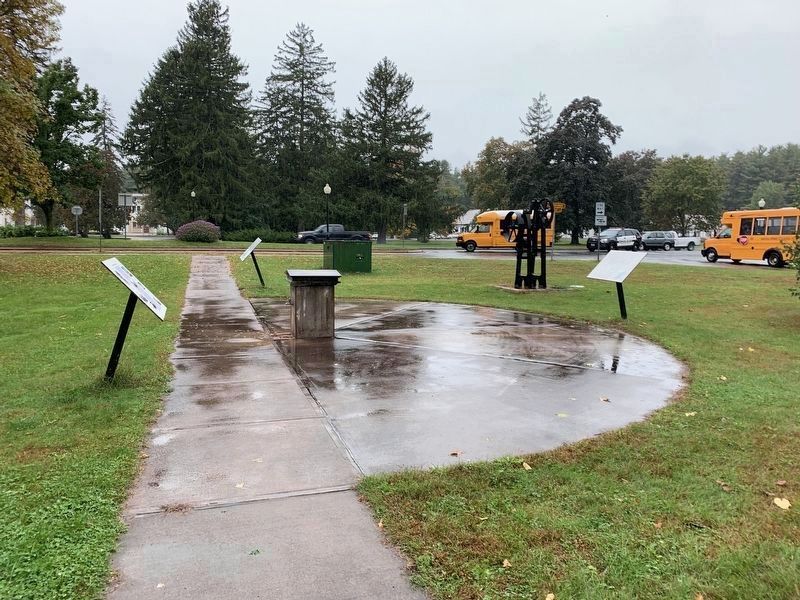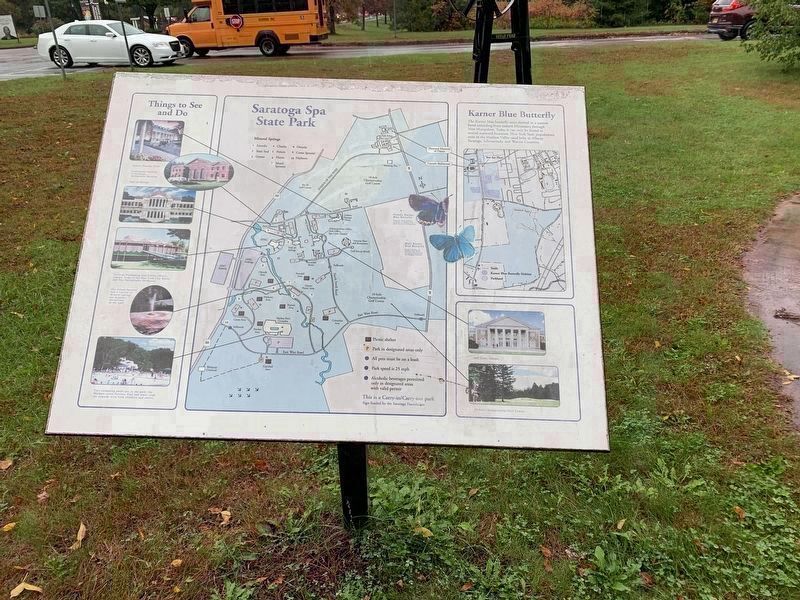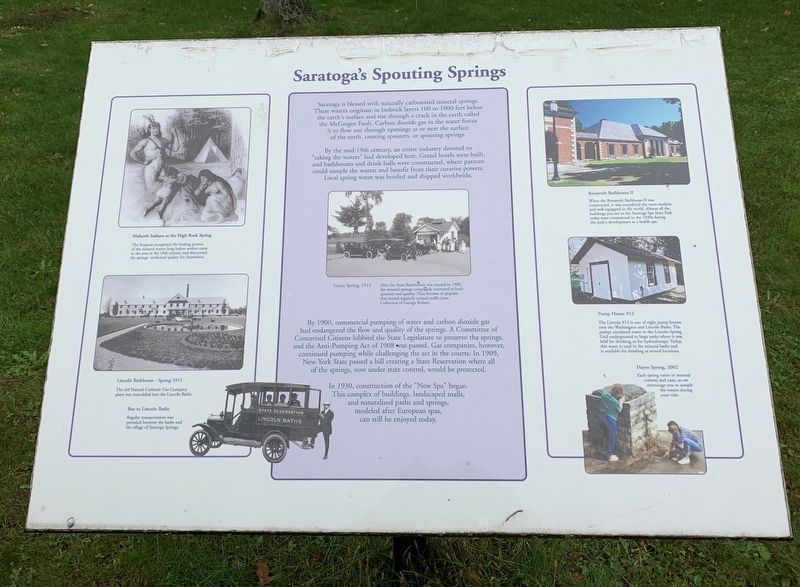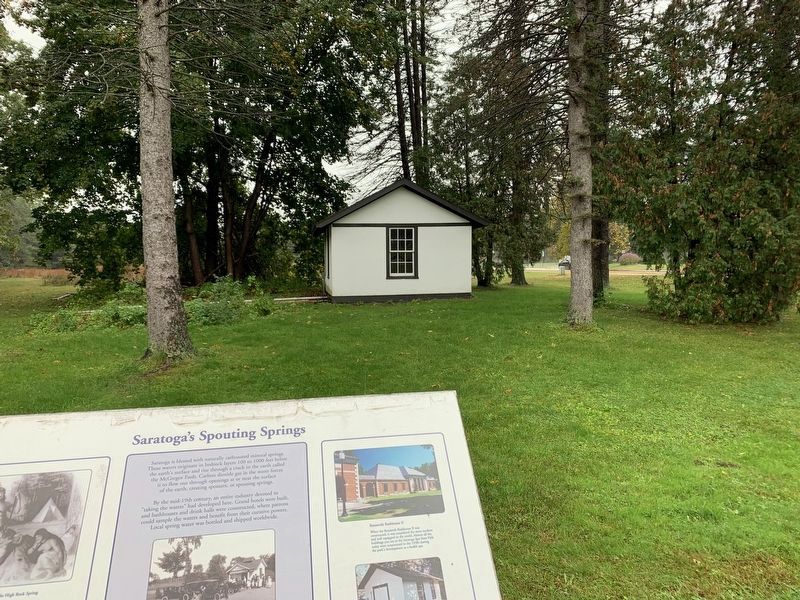Saratoga Springs in Saratoga County, New York — The American Northeast (Mid-Atlantic)
Saratoga’s Spouting Springs
Saratoga is blessed with naturally carbonated mineral springs. These waters originate in bedrock layers 100 to 1000 feet below the earth’s surface and rise through a crack in the earth called the McGregor Fault. Carbon dioxide gas in the water forces it to flow through the openings at or near the surface of the earth, creating spouters or spouting springs.
By the mid-19th century, an entire industry devoted to “taking the waters” had developed here. Grand hotels were built, and bathhouses and drink halls were constructed, where patrons could sample the waters and benefit from their curative powers. Local spring water was bottled and shipped worldwide.
By 1900, commercial pumping of water and carbon dioxide gas had endangered the flow and quality of the springs. A Committee of Concerned Citizens lobbied the State legislature to preserve the springs, and the Anti-Pumping Act of 1908 was passed. Gas companies, however, continued pumping while challenging the act in the courts. In 1909, New York State passed a bill creating a State Reservation where all of the springs, now under state control, would be protected.
In 1930, construction of the “New Spa” began. This complex of buildings, landscaped malls, and naturalized paths and springs, modeled after European spas, can still be enjoyed today.
Left Inset:
Mohawk Indians at the High Spring
The Iroquois recognized the healing powers of the mineral waters long before the settlers came to the area in the 18th century and discovered the springs’ medicinal quality for themselves
Lincoln Bathhouse - Spring 1915
The old Natural Carbonic Gas Company plant was remodeled into the Lincoln Baths.
Bus to Lincoln Baths
Regular transportation was provided between the baths and the village of Saratoga Springs.
Right Inset:
Roosevelt Bathhouse II
When the Roosevelt Bathhouse II was constructed, it was considered the most modern and well equipped in the world. Almost all the buildings you see in Saratoga State Park today were constructed in the 1930s during the park’s development as a health spa.
Lincoln #12 Pump House
The Lincoln #12 is one of eight pump houses near the Washington and Lincoln Baths. The pumps circulated water in the Lincoln Spring Grid underground to large tanks where it was held for drinking or for hydrotherapy. Today, this water is used in the mineral baths and is available for drinking at several locations.
Hayes Spring, 2002
Each spring varies in mineral content and taste, so we encourage you to sample the waters during your visit.
Topics. This historical marker is listed in these topic lists: Environment • Industry & Commerce • Settlements & Settlers.
Location. 43° 3.916′ N, 73° 47.3′ W. Marker is in Saratoga Springs, New York, in Saratoga County. Marker is at the intersection of South Broadway (U.S. 9) and Crescent Street, on the right when traveling north on South Broadway. Touch for map. Marker is in this post office area: Saratoga Springs NY 12866, United States of America. Touch for directions.
Other nearby markers. At least 8 other markers are within walking distance of this marker. Lincoln Bathhouse (about 500 feet away, measured in a direct line); Saratoga County Spanish-American War Memorial (approx. 0.4 miles away); Saratoga Springs Civil War Memorial (approx. 0.6 miles away); The Deer Park Spring (approx. 0.8 miles away); World War Memorial Pavillion (approx. 0.9 miles away); Columbian Spring (approx. 0.9 miles away); Congress Park (approx. 0.9 miles away); Congress Spring (approx. 0.9 miles away). Touch for a list and map of all markers in Saratoga Springs.

Photographed By Steve Stoessel
3. Saratoga’s Spouting Springs
Marker is in a Welcome Center for Saratoga Spa State Park and Saratoga Springs. The park is across the street past the middle school bus. The other markers are maps to the park and Saratoga Springs. The machine in the right middle ground is an old Gould water pump.

Photographed By Steve Stoessel
4. Park Map
This marker stands near the Lincoln Spring (#1) located at the second intersection from the top in the northeast corner of the map (or third up from the butterfly).
Saratoga State Park
Mineral Springs:
1 Lincoln
2 State Seal
3 Geyser
4 Charlie
5 Polaris
6 Hayes
7 Island Spouter
8 Orenda
9 Coesa Spouter
10 Hathorn
Things to See and Do:
Gideon Putnam Hotel
Conceptual Drawing of Saratoga Automobile Museum
Hall of Springs
Saratoga Performing Arts Complex (SPAC), summer home of the New York City Ballet and the Philharmonic Orchestra
The Island Spouter and a variety of mineral springs are popular attractions at the park
Two swimming pools are in the park; the Olympic–sized Peerless pool and water slide are popular with both children and adults.
SPA Theatre
18-hole Championship Golf Course
Karner Blue Butterfly
The Karner blue butterfly once thrived in a narrow band extending from eastern Minnesota through New Hampshire. Today it can only be found in several scattered area locations. New York State populations exist in the Hudson Valley sand belts in Albany, Saratoga Springs, Schenectady and Warren Counties.
Saratoga State Park
Mineral Springs:
1 Lincoln
2 State Seal
3 Geyser
4 Charlie
5 Polaris
6 Hayes
7 Island Spouter
8 Orenda
9 Coesa Spouter
10 Hathorn
Things to See and Do:
Gideon Putnam Hotel
Conceptual Drawing of Saratoga Automobile Museum
Hall of Springs
Saratoga Performing Arts Complex (SPAC), summer home of the New York City Ballet and the Philharmonic Orchestra
The Island Spouter and a variety of mineral springs are popular attractions at the park
Two swimming pools are in the park; the Olympic–sized Peerless pool and water slide are popular with both children and adults.
SPA Theatre
18-hole Championship Golf Course
Karner Blue Butterfly
The Karner blue butterfly once thrived in a narrow band extending from eastern Minnesota through New Hampshire. Today it can only be found in several scattered area locations. New York State populations exist in the Hudson Valley sand belts in Albany, Saratoga Springs, Schenectady and Warren Counties.
Credits. This page was last revised on August 17, 2022. It was originally submitted on October 9, 2019, by Steve Stoessel of Niskayuna, New York. This page has been viewed 213 times since then and 22 times this year. Photos: 1, 2, 3, 4. submitted on October 9, 2019, by Steve Stoessel of Niskayuna, New York. • Michael Herrick was the editor who published this page.

